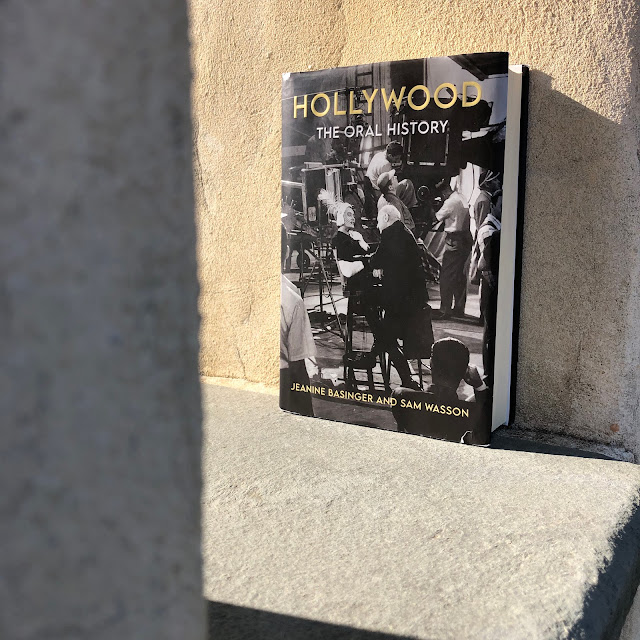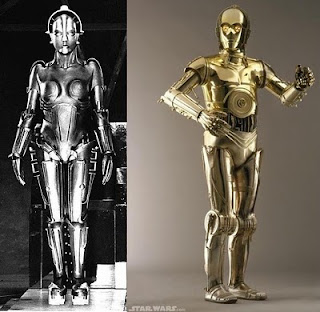BOOK REVIEW by CHRIS MICH: JEANINE BASINGER AND SAM WASSON’S HOLLYWOOD – THE ORAL HISTORY
 |
| Photo by Chris Mich |
The idea of this book is overwhelming: a 740-page oral history of Hollywood from the early days of silent cinema to the effects of streaming platforms on modern film industry. Structurally, it’s just carefully organized, out-of-context quotes lifted out of AFI archival interviews to tell the grand, overarching story of Hollywood film production – or so it would seem. For in the blocks of quotes, I began to see the authors (or should I say “editors” or “collage artists”?) Jeanine Basinger and Sam Wasson in the text with their own quotes. The book’s AFTERWORD helps shed some light on the process. Therefore, let’s begin at the end:
“Reading and editing more than three thousand transcripts is a daunting task. We studied every Harold Lloyd Seminar, every oral history, every AFI-sponsored conference on film education, and were overwhelmed with the richness of choices. We also had the opportunity to use Sam Wasson’s 2022 interview with Michael Ortiz, as well as Jeanine Basinger’s interviews and conversation with individuals such as Frank Capra, Raoul Walsh, Richard Schickel, and others. Our selection process – and the invevitable cuts and eliminations was very difficult…”
No doubt. This style of reporting – using back-to-back quotes, surgically-removed from original conversations but sandwiched together with like-minded (or not so like-minded) opinions to tell a moving, building story – isn’t easy. It became all the rage circa 2015 in various entertainment magazines. So much so, that I wrote a corporate newsletter article in this fashion about a Star Wars #ForceFriday commercial I wrote, directed and produced in conjunction with the release of Star Wars: The Force Awakens. As I constructed my own 4-page article, I realized how difficult it was to create a logical and entertaining read using only quotes – no intro, no outro, no bridges to transition from one quoted thought to another. I also knew I had to add a quote or two from myself – since I was involved in the production – to provide the missing information. Basinger and Wasson do just that, too, but only briefly – which is why it seemed so out of place and odd. That said, the book is mammoth and enthralling. As they also wrote in their AFTERWARD…
“This book is a labor of love, and as we worked, our respect for the working world of Hollywood – those much-maligned individuals who have given us our American movie heritage – grew even larger and deeper.”
The book does its job. It gives you an inside look at the glory days of the Studio system – and its downfall. It unspools the chaos of the 1950s and 1960s and marches you into the 1970s with soundbite after soundbite of the next wave of filmmakers that would forever change the industry and the world. It laments the 1980s “birth of the deal” and smirks at the 1990s “rise of the independents” and then careens into the 21st century ending with everyone’s opinion on how lucky or sucky the industry is right now. It even takes a stab at the conceptions (or misconceptions) of gender in Hollywood. No stone unturned, just select findings of what was under those stones.
The book has the usual films you would expect in an extensive film history lesson…including many titles we’ve covered on this blog ranging from Gone with the Wind (1939) to Waterworld (1995).
Two things really jumped out at me from the pages of this book. It was like: “BAM! I’m here just for you!”
The first surprise was the unexpected appearance of Henry Mancini-scored films. Not the popular, Academy Award-winning titles associated with Mancini, these mentioned titles are ones with ugly box office performances or other misfortunes. Here are Mancini-scored films in Basinger and Wasson’s book – along with links to my reviews of these films on Letterboxd:
Mr. Hobbs Takes a Vacation (1962)
The Molly Maguires (1970)
Darling Lili (1970)
The Great Waldo Pepper (1975)
 |
| Photo taken by Chris Mich at The Jimmy Stewart Museum. This is one of the four Henry Mancini-scored films in Basinger and Wasson's book Hollywood - The Oral History (2022). |
Another fantastic surprise was the inclusion of my all-time favorite TV show, The Young Indiana Jones Chronicles (1992-1993) as Basinger and Wasson approach the edge of Jurassic Park (1993) and the CG effects era. From page 712:
“GEORGE LUCAS: The goal was to create a digital character that looked like an actual character. There were testing grounds for the special effects we were working on, like The Young Indiana Jones Chronicles, and eventually we arrived at a stage where we said, 'Why don’t we try to do a digital dinosaur?'...”
The Young Indiana Jones Chronicles went through several re-edits and retitling - after all, it's a George Lucas property. Currently, it's marketed as a movie series (edited from the TV episodes) known as The Adventures of Young Indiana Jones. These movies are available on Disney+. Here's an TV spot for when the show first aired...
Classic film fans, please note: The Young Indy movie Hollywood Follies (1994) gets Indy entangled in 1920s behind-the-scenes Hollywood misadventures with John Ford, Erich von Stroheim, Irving Thalberg, and Wyatt Earp. It's a very entertaining episode for film nerds! How big of a Young Indy fan am I? Well, I just have to let you know that its star Sean Patrick Flanery (Powder, The Boondock Saints, Suicide Kings, Nefarious) sent me a cameo video for my 50th Birthday.
Back to the book: Yes, the book has it all – or, at least, a lot. How directors worked. How crazy Judy Garland seemed to the crew. Who smoked pot in the edit bay. It even included a hot-take on film history books from director/producer George Cukor (My Fair Lady, The Philadelphia Story, Gaslight, Les Girls)…
“GEORGE CUKOR: You know, there’s an awful lot of crap written, this literature about Hollywood in the past, that people want to know, and for the most part, I think it’s a waste of time. They’re all stories, and I know. I read certain books – books written about Katharine Hepburn – they ought to shoot the man who wrote it, because he didn’t know anything about it, and I think it’s just a moneymaking scheme and a lot of them are stupid and detestable.” (p. 514)
Um, okay. Noted.
In short, this book is no short book. It’s a hefty tome that you’ll lug around for a while to read a little bit here or a whole lot there. Hollywood – The Oral History (2022) clearly illustrates that while everyone likes to think they have Hollywood all figured out, they don’t. As William Goldman put it when it comes to Hollywood: “Nobody knows anything.” It's just fun trying to determine what’s truth and what’s tinsel in Tinseltown.
 |
| Photo by Chris Mich |
This post is an official entry in the 2023 Classic Film Reading Challenge. Special thanks to Out of the Past blogger Raquel Stecher for hosting the challenge and giving our blog a shout-out now and then. To join us in this summer fun endeavor, visit Raquel’s blog for more details.
#classicfilmreading


Great post! My favorite Young Indiana Jones episode is the one with the train heist.
ReplyDeleteCool post! Reading this book was a daunting task, but your in-depth analysis and connection to some of your favorite artists, movies, and shows exemplifies the beneficial and fun experience of reading "Hollywood: The Oral History".
ReplyDeleteI've read all sorts of mixed reactions to this book. Thank you for breaking it all down. I'm a little overwhelmed by the concept? Shorter books that aren't really short in scope always make me nervous! I appreciate your review!
ReplyDeleteThanks, Raquel! Reading this book in a limited time frame did feel like "work" at times - but it's all fascinating material. I was told this is a good "breakfast book" to flip through in the morning. Having finished it, I agree. Read this book when you can.
ReplyDelete